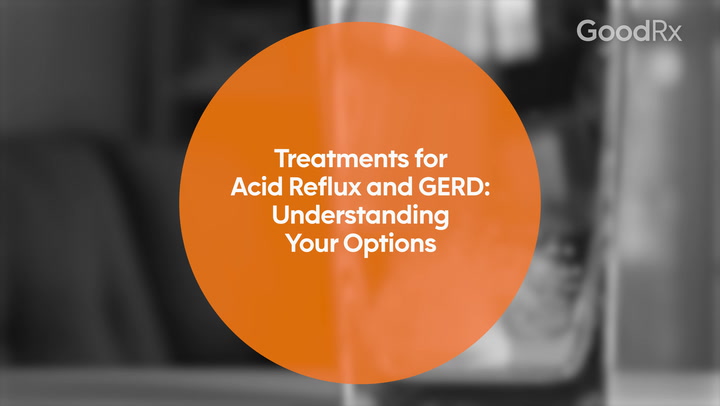
Is Omeprazole an Antacid? Pharmacists Answer 13 FAQs About This Common PPI
Key takeaways:
Omeprazole (Prilosec, Prilosec OTC) is used to treat conditions like heartburn, gastroesophageal reflux disease (GERD), and erosive esophagitis. Though some may think of it as an antacid, it’s not. It’s a proton pump inhibitor.
The best time to take omeprazole is 30 to 60 minutes before a meal, typically in the morning before breakfast if you take it once a day. If you take it twice daily, take the second dose before dinner. Avoid taking it at night unless directed, as omeprazole relies on food-triggered acid production to work.
Long-term omeprazole use may pose some unique risks, including weakened bones, and kidney or heart problems. However, these risks are rare and not definitively proven in all cases. Still, it's typically best to use the lowest dose for the shortest amount of time possible. But follow your prescriber’s instructions, as leaving a gastrointestinal condition untreated can have risks of its own.
Access savings on related medications
Table of contents
Omeprazole (Prilosec, Prilosec OTC) is a proton pump inhibitor (PPI) that treats many common digestive conditions like heartburn and gastroesophageal reflux disease (GERD). Heartburn is caused by acid reflux. Acid reflux is when stomach acid flows backwards into your esophagus (a tube that connects your mouth to your stomach). Heartburn can be mild, but if it happens often, it can be a sign of GERD, which is a more serious condition.
Omeprazole is available as a brand-name and generic medication. And it’s available over the counter (OTC) at certain doses. Other doses require a prescription. If you’re taking omeprazole, there’s a few things GoodRx pharmacists think you should know.
1. Is omeprazole an antacid?
Many people wonder if omeprazole is an antacid, and the answer is no. Antacids are common OTC medications that relieve symptoms of acid reflux, like heartburn. They work by neutralizing stomach acid. Examples of antacids include calcium carbonate (Tums) and calcium carbonate / magnesium hydroxide (Rolaids).
Search and compare options
Like antacids, omeprazole is available OTC. But omeprazole isn’t an antacid. Omeprazole is a PPI that treats many digestive conditions that antacids can’t. For example, omeprazole treats conditions like GERD, stomach ulcers, and erosive esophagitis (inflammation of the esophagus). Antacids, on the other hand, should only be used to treat mild symptoms of acid reflux.
If you find yourself needing an OTC antacid for more than 2 weeks, talk to a healthcare professional. They might recommend stronger medication like an histamine-2 antagonist (H2 blocker) or PPI.
2. How does omeprazole work?
All PPIs work similarly to each other. They work by blocking an enzyme (protein) in the stomach known as the proton pump.
Under normal circumstances, the proton pump helps create acid in the stomach. Having some amount of acid in the stomach is a normal part of digestion, but having too much can cause acid reflux. By blocking the proton pump, PPIs limit acid production. And less acid in the stomach helps relieve symptoms of acid reflux.
PPIs are a first-choice medication for the treatment of GERD. And typically, one PPI isn’t recommended over another. So if you need a PPI, your healthcare professional can help you pick the right one for you based on your personal preferences and medical history.
3. Is generic omeprazole equally as effective as brand-name Prilosec?
Most omeprazole products are available as lower-cost generics. Though some research has questioned whether generic omeprazole is as effective as brand-name Prilosec, generic medications are considered just as effective as their brand-name counterparts.
All forms of omeprazole are delayed-release (DR) products. DR products are made so the active medication is released in the intestines (instead of the stomach). In the table below, we’ll detail all forms of omeprazole.
| Tablets | Orally disintegrating tablets (ODTs) | Capsules | Granule packets | |
|---|---|---|---|---|
| Generic | 20 mg | 20 mg | 10, 20, and 40 mg | |
| Brand-name | 20 mg | 2.5 mg and 10 mg |
Brand-name Prilosec may be preferred if you have trouble swallowing. The granule packets can be mixed into water to make an oral liquid that you drink. But the generic capsules can also be opened and sprinkled onto a tablespoon of applesauce if you have trouble swallowing.
OTC products include 20 mg tablets, 20 mg capsules, and 20 mg ODTs. But if your prescriber recommends the 10 mg or 40 mg capsules, you’ll need a prescription. You’ll also need a prescription for the granule packets.
4. When is the best time to take omeprazole?
It’s typically best to take omeprazole 30 to 60 minutes before a meal. Taking it before a meal is important because food triggers your stomach to produce acid. And PPIs work best when acid is present. Taking it 30 to 60 minutes before a meal is best because it takes omeprazole this long to reach the proton pumps.
Stop the burning: Real people share what it’s like to take omeprazole for heartburn.
Omeprazole side effects: Read what experts say about omeprazole side effects — from headaches to stomach pain — and how to manage them.
Stopping a PPI: Want to stop omeprazole? Experts talk about the ways to do it.
If you’re only taking omeprazole once a day, it’s typically best to take your dose before breakfast. In situations where omeprazole is taken twice daily, taking it 30 to 60 minutes before breakfast and dinner is best.
Many people wonder whether taking omeprazole at night is as effective as taking it in the morning. Since there isn’t enough food in your stomach overnight to trigger acid production, taking a dose before bedtime is not as effective. If you’re having acid reflux symptoms during the night, talk to your healthcare professional. In some cases, they may recommend an H2 blocker, such as famotidine (Pepcid AC). Unlike omeprazole, H2 blockers aren’t reliant on the presence of acid to work. So you can take them without regard to meals.
5. Can you take omeprazole on an as-needed basis?
When you first start omeprazole, it’s typically best to take it daily. In many cases, the goal is to stop taking your PPI after a certain amount of time, once your symptoms resolve.
However, you may still benefit from intermittent use of a PPI, or other acid-suppressing medication, if mild symptoms pop up after you stop your PPI. In this case, PPIs, H2 blockers, or antacids may be used intermittently to help with your symptoms. Taking PPIs on an as-needed basis has been shown to be effective, and reduces your risk of long-term side effects.
But before taking PPIs as-needed, talk to your prescriber. If you’re having continued symptoms, there’s a chance you’ll need long-term acid suppression with PPIs to manage your condition. And certain conditions, such as Barrett’s esophagus, are best treated with daily PPI use long term.
6. What is the biggest side effect of omeprazole?
The most common side effect of omeprazole is a headache. In clinical trials, it happened in about 7% of people taking this medication. And the risk may be highest when you first start taking omeprazole.
Other possible side effects include stomach pain, nausea, and gas. But usually, side effects from short-term omeprazole use are mild and can be managed at home.
7. Is omeprazole safe to take long term?
Most omeprazole side effects are mild if you’re taking it short term. However, long-term use of omeprazole can cause more serious risks, although they’re rare. It may also lead to lung infections, weakened bones, and severe diarrhea. It can also increase your risk of kidney problems. However, it’s important to note that although research has associated PPIs with these risks, it’s not certain that PPIs cause them.
That said, there’s no official definition for what “long-term” PPI use is. It could be as little as 2 months. Or it could be 6 months or longer.
For most conditions (including GERD), omeprazole is taken for 1 to 2 months. But for other conditions like Barrett’s esophagus, you may need to take it for longer. If a healthcare professional suggests taking omeprazole for many months, talk to them about the risks and benefits of long-term PPI use.
Typically, OTC omeprazole should only be taken for 14 days at a time. If you need to take it longer than that to help with your symptoms, talk to your healthcare professional. You may have a more serious condition that needs to be treated.
8. Can omeprazole cause heart problems?
We’ve discussed long-term risks of omeprazole above. But whether PPI use increases the risk of heart attack is of particular interest. For example, one review of almost 3 million people with GERD found that long-term PPI use may lead to a greater risk of heart attack, whether you have existing heart problems or not. Another review of about 19,000 people with Type 2 diabetes also found that PPI use was associated with a great risk of heart attack, coronary artery disease, and heart failure. It was also associated with a higher risk of death.
But other research shows conflicting results. For example, an analysis of 10 studies didn’t find a link between PPI use and heart problems.
Even if PPIs raise the risk of heart attack, it may still be considered a rare occurrence. For example, one study found that over 4,000 people need to receive PPI treatment for one heart attack to occur. So, the benefits might outweigh the risks for many people.
If you’re concerned about the risk of heart attack with PPIs, talk to your healthcare professional. They can help you weigh the risks and benefits. They can also help make sure you take your PPI for the shortest amount of time possible. This will make it less likely to experience any negative long-term effects.
9. Does omeprazole affect your gut?
Some studies show that PPIs can affect the bacteria in your gut. In some cases, this may be harmful.
For example, some studies from the 1990s found that omeprazole treatment may change the type of bacteria in the gut and raise the amount of it. This may be harmful because bacterial overgrowth has been linked to many medical conditions, including nutritional deficiencies.
Some newer research has also found that PPIs may cause small intestinal bacterial overgrowth (SIBO) specifically. SIBO is a disruption of the normal bacteria in your small intestine specifically. It can cause many bothersome symptoms, like bloating and gas. And it can lead to nutritional deficiencies in severe cases.
Even so, experts don’t know for certain whether these changes actually cause significant health problems. And PPIs are a valuable tool for treating conditions like GERD. More research might help us better understand the risks of gut bacteria changes from omeprazole.
10. How can you stop taking omeprazole?
There are different ways to stop taking omeprazole. Some people may prefer to reduce the dose of the medication slowly (called a taper), but research shows this may not be necessary. So talk to your prescriber about whether you should taper your PPI dose or just stop it completely.
Additionally, talk to them about taking omeprazole as needed if your symptoms return. They may recommend as-needed use of a PPI or other acid-suppressing medication such as an H2 blocker or antacids, since these typically have fewer side effects than PPIs. But they aren’t as effective for conditions like GERD or esophagitis.
11. Is omeprazole safe during pregnancy?
It may be safe to take omeprazole during pregnancy. In fact, omeprazole is one of the most studied PPIs in pregnancy.
Research has shown that PPI use isn't linked to birth defects, preterm birth, or miscarriage. It may even lower the risk of preeclampsia depending on when you take it during your pregnancy.
If you’re pregnant or planning to become pregnant, talk to a healthcare professional about whether it’s safe to take omeprazole or any other PPI.
12. What should you avoid while taking omeprazole?
Omeprazole has drug interactions to be aware of. This includes potential interactions with medications such as:
Clopidogrel (Plavix)
Warfarin (Coumadin, Jantoven)
Citalopram (Celexa)
Digoxin (Lanoxin)
Besides medications, there are other things to keep in mind if you take a PPI like omeprazole. For instance, you may want to avoid, or cut back on:
Foods that can worsen acid reflux: This is common with fried foods or fruits high in acid.
Alcohol and caffeine: These can trigger heartburn.
Eating too close to bedtime: Lying down can make acid move from your stomach to your esophagus and cause acid reflux symptoms.
Tight clothing: This can put pressure on your stomach and can encourage acid to move towards your esophagus.
13. Is omeprazole the best PPI for acid reflux?
PPIs are generally considered equally effective, despite some research that shows certain PPIs, like esomeprazole (Nexium), may be more effective than omeprazole in certain situations. However, it’s not clear how much these studies translate to real-world differences between PPIs.
Additionally, PPIs have similar side effects. But omeprazole is known to have more drug interactions than other PPIs, such as pantoprazole (Protonix). So if you take several interacting medications, another PPI may be a better option.
The bottom line
Omeprazole (Prilosec, Prilosec OTC) is a proton pump inhibitor (PPI) that helps treat heartburn, gastroesophageal reflux disease (GERD), and other digestive disorders. It’s not an antacid, though antacids like calcium carbonate (Tums) also treat heartburn and are available over the counter, like omeprazole.
It’s best to take omeprazole 30 to 60 minutes before your first meal of the day. If you take it twice a day, take it before breakfast and dinner. Omeprazole usually isn’t as effective if it’s taken at night before bedtime because it relies on the presence of food to work effectively.
For many people, long-term omeprazole use isn’t necessary. It’s been associated with negative effects, such as heart problems and weakened bones. But for some people, long-term use may be required to control their gastrointestinal condition. So ask your healthcare professional how long to take omeprazole, as they can help you weigh the risks and benefits.
Why trust our experts?


References
Antunes, C., et al. (2023). Esophagitis. StatPearls.
Ariel, H., et al. (2019). Cardiovascular risk of proton pump inhibitors. Methodist Debakey Cardiovascular Journal.
Bardhan, K. D. (2025). Intermittent and on-demand use of proton pump inhibitors in the management of symptomatic gastroesophageal reflux disease. The American Journal of Gastroenterology.
Covis Pharma. (2024). Prilosec- omeprazole magnesium granule, delayed release [package insert].
Fried, M., et al. (1994). Duodenal bacterial overgrowth during treatment in outpatients with omeprazole. Gut.
Geng, T., et al. (2022). Proton pump inhibitor use and risks of cardiovascular disease and mortality in patients with type 2 diabetes. The Journal of Clinical Endocrinology & Metabolism.
Gerson, L. B. (2012). Treatment of gastroesophageal reflux disease during pregnancy. Gastroenterology & Hepatology.
Haastrup, P. F., et al. (2021). When does proton pump inhibitor treatment become long term? A scoping review. BMJ Open Gastroenterology.
Hastie, R., et al. (2019). Proton pump inhibitors and preeclampsia risk among 157720 women. Hypertension.
Kang, S. J., et al. (2021). On-demand versus continuous maintenance treatment of gastroesophageal reflux disease with proton pump inhibitors: A systemic review and meta-analysis. Journal of Neurogastroenterology and Motility.
Katz, P. O., et al. (2022). ACG clinical guideline for the diagnosis and management of gastroesophageal reflux disease. The American Journal of Gastroenterology.
Kiecka, A., et al. (2023). Proton pump inhibitor-induced gut dysbiosis and immunomodulation: Current knowledge and potential restoration by probiotics. Pharmacological Reports.
MotherToBaby. (2024). Omeprazole | esomeprazole.
Nolde, M., et al. (2022). Proton pump inhibitors and the risk of cardiovascular events and cardiovascular mortality: A systematic review and meta-analysis of observational studies. European Journal of Internal Medicine.
Pasternak, B., et al. (2010). Use of proton-pump inhibitors in early pregnancy and the risk of birth defects. The New England Journal of Medicine.
PD-Rx Pharmaceuticals. (2024). Omeprazole capsule, delayed release [package insert].
Shah, N. H., et al. (2015). Proton pump inhibitor usage and risk of myocardial infarction in the general population. PLoS One.
Shih, C. J., et al. (2014). Proton pump inhibitor use represents an independent risk factor for myocardial infarction. International Journal of Cardiology.
Shimatani, T., et al. (2006). Acid-suppressive effects of generic omeprazole: Comparison of three brands of generic omeprazole with original omeprazole. Digestive and Liver Disease.
Spiegel, B. M. R., et al. (2008). Bacterial overgrowth and irritable bowel syndrome: Unifying hypothesis or a spurious consequence of proton pump inhibitors? The American Journal of Gastroenterology.
Targownik, L. E., et al. (2022). AGA clinical practice update on de-prescribing of proton pump inhibitors: Expert review. Gastroenterology.
Thorens, J., et al. (1996). Bacterial overgrowth during treatment with omeprazole compared with cimetidine: A prospective randomised double blind study. Gut.
Was this page helpful?
Compare other gerd drugs
Related Articles
Browse medications
View AllResearch prescriptions and over-the-counter medications from A to Z, compare drug prices, and start saving.
























